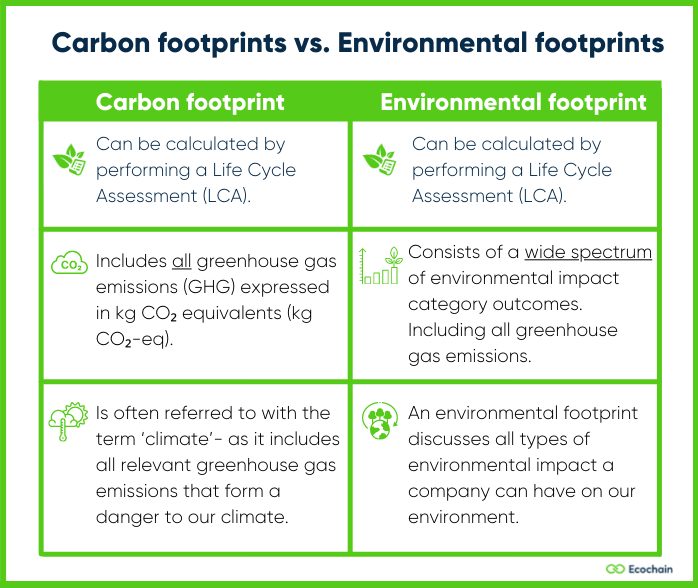Carbon footprints often make up the largest impact hotspot in a company’s operations. And greenhouse gas emissions (GHG) are THE term that is linked to the climate crisis.
But, our ecosystems are made up of many different factors that all support each other as a cohesive whole. And- the same goes for the impact your company has on the environment. By focusing on carbon footprints, are we forgetting the rest of the ‘environment’ in environmental footprint?
What are the risks of a tunnel vision on carbon footprints in your sustainability strategy?
This article:
- The difference between carbon vs environmental footprints
- The risks of carbon tunnel visions & how to escape them
Carbon vs. Environmental Footprints
Let’s first look at the difference between the two. Because they are often used interchangeably.
‘Carbon footprint’
A carbon footprint can be calculated by performing a Life Cycle Assessment. It includes all greenhouse gas emissions (GHG) expressed in kg CO₂ equivalents (kg CO₂-eq). These equivalents make it possible to come to a single metric for global warming potential, expressed in tons of CO₂. Even if the global warming effect is not caused by CO₂ but by another GHG, such as methane or laughing gas. This footprint is also often referred to with the term ‘climate’, as it includes all relevant greenhouse gas emissions that form a danger to our climate issues.
‘Environmental footprint’
Now, an ‘environmental’ footprint is the total package. It consists of a wide spectrum of environmental impact category outcomes calculated by a Life Cycle Assessment (LCA), that includes climate emissions.
Some of these other impact categories, next to climate emissions are;
- Eutrophication: This impact category covers the impacts on terrestrial and aquatic environments due to the emission of nitrogen-containing compounds. Think of over-fertilization or nitrogen-extensive construction processes. This is a serious issue incorporated in many legislations and even puts some construction projects on hold in The Netherlands.
- Acidification: This category indicates the potential acidification of soils and water as a result of the release of certain gases, such as nitrogen oxides and sulfur oxides. One of the more ‘famous’ results here is acid rain. As you can imagine, acidification can heavily impact ecosystems and may even cause damage to buildings.
- Toxicities: Toxicities include both impact on human health as well as ecosystems (freshwater organisms) due to toxic substances that are emitted to the environment. The resulting impact on human health could, for example, be cancer.
- Ozone depletion: This category indicates the emissions to air that cause destruction (a gradual thinning) of the Earth’s ozone layer. It’s also called ozone layer depletion- and causes increased UV radiation levels on our Earth’s surface. This is of course damaging to human health- think of increases in types of skin cancers. But UV radiation also affects agricultural productivity (reduces plant growth).
Although these two footprint types (carbon/climate & environmental) are calculated through the same means (LCA). An environmental footprint is the only one that discusses all types of environmental impacts a company can have on our environment.

A Carbon Footprint isn’t always the biggest impact chunk
There’s a reason carbon and its notorious brothers and sisters from the greenhouse gas family are so important. They contribute significantly to global warming, which results in many different changes in our climate. And this often comes back in a company or product’s environmental scores.
However, it’s not always the case that only carbon makes up the biggest impact chunk in your footprint. A good example is the Environmental Profit & Loss Account (EP&L) from Kering Group, which is the mother company of Gucci, Yves Saint Laurent, and many other luxury brands.
In image 1, you see that:
- next to GHG emissions (climate) with 35%
- land use actually contributes significantly to Kering’s environmental impact with 31%.
- and so does water pollution with 10% of the total environmental footprint.
Excessive greenhouse gas emissions aren’t our only problem. Biodiversity, land use, or water mismanagement (in water-scarce countries), are equally pressing issues in our collective environmental crisis. We shouldn’t forget that.

Conclusion: carbon tunnel visions are a risk
Simply put: solely focusing on carbon footprint, can result in too much focus on a single issue in your sustainability strategy. In doing so, you potentially exclude other relevant impact outcomes of your products that heavily impact the environment as well.
On top of that, your reduction efforts can increase impact in other impact categories.
Maybe switching from fossil to biobased resources seems like a good way to reduce emissions in your product’s production. However, this can result in extra land use/use of fertilizers/pesticides- which then negatively affects biodiversity and disrupts local ecosystems.
Life Cycle Assessments offer the whole package
Always look at your environmental footprint as a whole. And model your impact reduction efforts accordingly.
Make Life Cycle Assessments (LCA) of your products and assess their full environmental impact. This ensures you don’t leave out on anything – and your actions aren’t damaging the environment in another way.
Start with LCA yourself! Read more about how to make LCAs in our full beginner’s guide.
